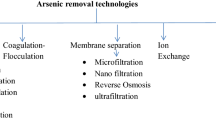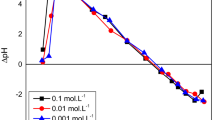Abstract
Arsenic removal has received much attention all over the world because of its toxicity and carcinogenicity. In the current research, the adsorption behavior of As(V) from aqueous solution onto Fe(III)-impregnated bentonite (Fe-Bent) was examined. Adsorption experiment results showed that the adsorption capacity of initial bentonite clay (Bent) was increased by Fe(III)-impregnation method. In Fe-Bent, the mononuclear Fe(III) cations, small oligomeric cluster and bulky FexOy particles were made such active sites identified by UV–Vis spectroscopy. X-ray diffraction results showed that Fe(III) species presented mainly in both crystalline and amorphous forms on the external surface of Fe-Bent. In an experimental study, the effect of different parameters such as contact times, arsenic concentrations, adsorbent dosages, pH and temperature conditions was investigated. Fe-Bent sample represented the maximum adsorption capacity of 10.06 mg L−1 to remove 5–20 mg L−1 of As(V) at pH = 6 and ambient temperature. In this experiment, the residual As(V) concentration decreased to less than 0.01 mg/L with the adsorption efficiency of 99% (i.e., below the limit of the WHO). The two- and three-parameter isotherm models revealed the best fit to the Freundlich, Sips, Toth, Temkin and Langmuir models, respectively. The isotherm models indicated the strong adsorption between arsenic and Fe-Bent. The adsorption kinetics was also considered by first-order, second-order and Elovich rate equations. It was noticed that the Fe-Bent adsorption followed the external surface reaction such as ligand exchange and surface complexation. The thermodynamics studies exposed that the process was spontaneous and endothermic for Fe-Bent.











Similar content being viewed by others
References
Abukhadra, M. R., Dardir, F. M., Shaban, M., Ahmed, E. A., & Soliman, M. F. (2018a). Superior removal of Co2+, Cu2+ and Zn2+ contaminants from water utilizing spongy Ni/Fe carbonate-fluorapatite; preparation, application and mechanism. Ecotoxicology and Environmental Safety,157, 358–368.
Abukhadra, M. R., Rabia, M., Shaban, M., & Verpoort, F. (2018b). Heulandite/polyaniline hybrid composite for efficient removal of acidic dye from water; kinetic, equilibrium studies and statistical optimization. Advanced Powder Technology,29(10), 2501–2511.
Ahmedzeki, N. S., Rashid, H. A., Alnaama, A. A., Alhasani, M. H., & Abdulhussain, Z. (2013). Removal of 4-nitro-phenol from wastewater using synthetic zeolite and kaolin clay. Korean Journal of Chemical Engineering,30(12), 2213–2218.
Bower, C. A., Reitemeier, R., & Fireman, M. (1952). Exchangeable cation analysis of saline and alkali soils. Soil Science,73(4), 251–262.
Chen, L., Xin, H., Fang, Y., Zhang, C., Zhang, F., Cao, X., et al. (2014). Application of metal oxide heterostructures in arsenic removal from contaminated water. Journal of Nanomaterials,2014, 2.
Chiban, M., Zerbet, M., Carja, G., & Sinan, F. (2012). Application of low-cost adsorbents for arsenic removal: A review. Journal of Environmental Chemistry and Ecotoxicology,4(5), 91–102.
Devi, R. R., Umlong, I. M., Das, B., Borah, K., Thakur, A. J., Raul, P. K., et al. (2014). Removal of iron and arsenic (III) from drinking water using iron oxide-coated sand and limestone. Applied Water Science,4(2), 175–182.
Doušová, B., Fuitová, L., Grygar, T., Machovič, V., Koloušek, D., Herzogová, L., et al. (2009). Modified aluminosilicates as low-cost sorbents of As (III) from anoxic groundwater. Journal of Hazardous Materials,165(1), 134–140.
Erhayem, M., Al-Tohami, F., Mohamed, R., & Ahmida, K. (2015). Isotherm, kinetic and thermodynamic studies for the sorption of mercury (II) onto activated carbon from Rosmarinus officinalis leaves. American Journal of Analytical Chemistry,6(01), 1.
Fazi, S., Amalfitano, S., Casentini, B., Davolos, D., Pietrangeli, B., Crognale, S., et al. (2016). Arsenic removal from naturally contaminated waters: A review of methods combining chemical and biological treatments. Rendiconti Lincei,27(1), 51–58.
Fenti, A., Iovino, P., & Salvestrini, S. (2019). Some remarks on “A critical review of the estimation of the thermodynamic parameters on adsorption equilibria. Wrong use of equilibrium constant in the Van’t Hoof equation for calculation of thermodynamic parameters of adsorption”. Journal of Molecular Liquids,273, 425–434.
Gitari, W. (2014). Attenuation of metal species in acidic solutions using bentonite clay: Implications for acid mine drainage remediation. Toxicological and Environmental Chemistry,96(2), 201–217.
Goldberg, S., & Johnston, C. T. (2001). Mechanisms of arsenic adsorption on amorphous oxides evaluated using macroscopic measurements, vibrational spectroscopy, and surface complexation modeling. Journal of Colloid and Interface Science,234(1), 204–216.
Ismadji, S., Soetaredjo, F. E., & Ayucitra, A. (2015). The kinetic studies in the adsorption of hazardous substances using clay minerals. In Clay materials for environmental remediation, Springer, pp. 113–120.
Jovanović, B. M., Vukašinović-Pešić, V. L., Veljović, Đ. N., & Rajaković, L. V. (2011). Arsenic removal from water using low-cost adsorbents—A comparative study. Journal of the Serbian Chemical Society,76(10), 1437–1452.
Khalfa, L., Cervera, M. L., Bagane, M., & Souissi-Najar, S. (2016). Modeling of equilibrium isotherms and kinetic studies of Cr(VI) adsorption into natural and acid-activated clays. Arabian Journal of Geosciences,9(1), 75.
Krupskaya, V., Zakusin, S., Tyupina, E., Dorzhieva, O., Zhukhlistov, A., Belousov, P., et al. (2017). Experimental study of montmorillonite structure and transformation of its properties under treatment with inorganic acid solutions. Minerals,7(4), 49.
Kumar, K. V. (2006). Comments on” Adsorption of acid dye onto organobentonite”. Journal of Hazardous Materials,137(1), 638–639.
Langsch, J. E., Costa, M., Moore, L., Morais, P., Bellezza, A., & Falcão, S. (2012). New technology for arsenic removal from mining effluents. Journal of Materials Research and Technology,1(3), 178–181.
Liu, Y., Dong, C., Wei, H., Yuan, W., et al. (2015). Adsorption of levofloxacin onto an iron-pillared montmorillonite (clay mineral): Kinetics, equilibrium and mechanism. Applied Clay Science,118, 301–307.
Lu, J. (1995). Comparative study on determination of iron contents in activated carbon. Linchan Huaxue Yu Gongye,15, 57–61.
Mar, K., Karnawati, D., Putra, D., Igarashi, T., & Tabelin, C. (2013). Comparison of Arsenic adsorption on lignite, bentonite, shale, and iron sand from Indonesia. Procedia Earth and Planetary Science,6, 242–250.
Markandeya, S., & Kisku, G. (2015). Linear and nonlinear kinetic modeling for adsorption of disperse dye in batch process. Research Journal of Environmental Toxicology,9, 320–331.
Mohan, D., & Pittman, C. U. (2007). Arsenic removal from water/wastewater using adsorbents—A critical review. Journal of Hazardous Materials,142(1), 1–53. https://doi.org/10.1016/j.jhazmat.2007.01.006.
Mohapatra, D., Mishra, D., Chaudhury, G. R., & Das, R. (2007). Arsenic (V) adsorption mechanism using kaolinite, montmorillonite and illite from aqueous medium. Journal of Environmental Science and Health Part A,42(4), 463–469.
Nayak, P. S., & Singh, B. (2007). Instrumental characterization of clay by XRF, XRD and FTIR. Bulletin of Materials Science,30(3), 235–238.
Oliveira, L. C., Rios, R. V., Fabris, J. D., Garg, V., Sapag, K., & Lago, R. M. (2002). Activated carbon/iron oxide magnetic composites for the adsorption of contaminants in water. Carbon,40(12), 2177–2183.
Polowczyk, I., Cyganowski, P., Ulatowska, J., Sawiński, W., & Bastrzyk, A. (2018). Synthetic iron oxides for adsorptive removal of arsenic. Water, Air, and Soil pollution,229(6), 203.
Pradisty, N. A., Sihombing, R., Howe, R. F., & Krisnandi, Y. K. (2017). Fe(III) oxide-modified indonesian bentonite for catalytic photodegradation of phenol in water. Makara Journal of Science,2017, 25–33.
Prathna, T., Sharma, S. K., & Kennedy, M. (2018). Application of iron oxide and iron oxide/alumina nanocomposites for arsenic and fluoride removal: A comparative study. Journal of Theoretical and Applied Nanotechnology, 6.
Prathna, T. C., Sharma, S. K., & Kennedy, M. (2017). Development of iron oxide nanoparticle adsorbents for arsenic and fluoride removal. Desalination and Water Treatment,67, 187–195.
Putra, E. K., Pranowo, R., Sunarso, J., Indraswati, N., & Ismadji, S. (2009). Performance of activated carbon and bentonite for adsorption of amoxicillin from wastewater: Mechanisms, isotherms and kinetics. Water Research,43(9), 2419–2430.
Ramstedt, M. (2004). Chemical Processes at the Water-Manganite (γ-MnOOH) Interface.
Ranjan, D., Talat, M., & Hasan, S. (2009). Biosorption of arsenic from aqueous solution using agricultural residue ‘rice polish’. Journal of Hazardous Materials,166(2), 1050–1059.
Shaban, M., Abukhadra, M. R., Shahien, M., & Ibrahim, S. S. (2018). Novel bentonite/zeolite-NaP composite efficiently removes methylene blue and Congo red dyes. Environmental Chemistry Letters,16(1), 275–280.
Shaban, M., Hassouna, M. E., Nasief, F. M., & AbuKhadra, M. R. (2017). Adsorption properties of kaolinite-based nanocomposites for Fe and Mn pollutants from aqueous solutions and raw ground water: Kinetics and equilibrium studies. Environmental Science and Pollution Research,24(29), 22954–22966.
Sigdel, A., Park, J., Kwak, H., & Park, P.-K. (2016). Arsenic removal from aqueous solutions by adsorption onto hydrous iron oxide-impregnated alginate beads. Journal of Industrial and Engineering Chemistry,35, 277–286.
Singh, D., Prasad, G., & Rupainwar, D. (1996). Adsorption technique for the treatment of As (V)-rich effluents. Colloids and Surfaces A: Physicochemical and Engineering Aspects,111(1–2), 49–56.
Stanić, T., Daković, A., Živanović, A., Tomašević-Čanović, M., Dondur, V., & Milićević, S. (2009). Adsorption of arsenic (V) by iron (III)-modified natural zeolitic tuff. Environmental Chemistry Letters,7(2), 161–166.
Thirunavukkarasu, O., Viraraghavan, T., & Subramanian, K. (2003). Arsenic removal from drinking water using iron oxide-coated sand. Water, Air, and Soil pollution,142(1–4), 95–111.
Timofeeva, M., Khankhasaeva, S. T., Chesalov, Y. A., Tsybulya, S., Panchenko, V., & Dashinamzhilova, E. T. (2009). Synthesis of Fe, Al-pillared clays starting from the Al, Fe-polymeric precursor: Effect of synthesis parameters on textural and catalytic properties. Applied Catalysis, B: Environmental,88(1–2), 127–134.
Tran, H. N., You, S.-J., Hosseini-Bandegharaei, A., & Chao, H.-P. (2017). Mistakes and inconsistencies regarding adsorption of contaminants from aqueous solutions: A critical review. Water Research,120, 88–116.
Türk, T., & Alp, I. (2014). Arsenic removal from aqueous solutions with Fe-hydrotalcite supported magnetite nanoparticle. Journal of Industrial and Engineering Chemistry,20(2), 732–738.
Türk, T., Alp, İ., & Deveci, H. (2009). Adsorption of As(V) from water using Mg–Fe-based hydrotalcite (FeHT). Journal of Hazardous Materials,171(1), 665–670. https://doi.org/10.1016/j.jhazmat.2009.06.052.
Uddin, M. K. (2017). A review on the adsorption of heavy metals by clay minerals, with special focus on the past decade. Chemical Engineering Journal,308, 438–462.
Weber, W. J., Jr., & DiGiano, F. A. (1996). Process dynamics in environmental systems. New York: Wiley.
Yamamura, S., Bartram, J., Csanady, M., Gorchev, H. G., & Redekopp, A. (2003). Drinking water guidelines and standards. Arsenic, Water, and Health: The State of the Art.
Yan, L.-G., Shan, X.-Q., Wen, B., & Owens, G. (2008). Adsorption of cadmium onto Al 13-pillared acid-activated montmorillonite. Journal of Hazardous Materials,156(1), 499–508.
Acknowledgements
The authors acknowledge the support of Iranian nanotechnology initiative council (INIC) for providing the financial support to carry out this research with Grant Number 127212.
Author information
Authors and Affiliations
Corresponding author
Additional information
Publisher's Note
Springer Nature remains neutral with regard to jurisdictional claims in published maps and institutional affiliations.
Rights and permissions
About this article
Cite this article
Barakan, S., Aghazadeh, V., Samiee Beyragh, A. et al. Thermodynamic, kinetic and equilibrium isotherm studies of As(V) adsorption by Fe(III)-impregnated bentonite. Environ Dev Sustain 22, 5273–5295 (2020). https://doi.org/10.1007/s10668-019-00424-2
Received:
Accepted:
Published:
Issue Date:
DOI: https://doi.org/10.1007/s10668-019-00424-2




